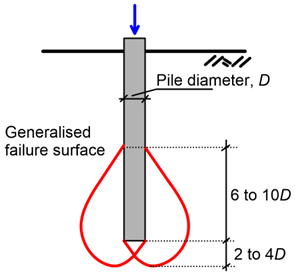6.11 Ultimate geotechnical strength of piles subjected to axial compressive load from SPT test results
Given difficulties (and costs) associated with obtaining undisturbed coarse-grained soil samples for laboratory testing, as discussed in Chapter 5.7, the collapse load of piles in homogeneous coarse-grained soil can be estimated directly from SPT test results, skipping the intermediate step of interpreting characteristic values of soil parameters. While such methods are rather obsolete, and have been replaced by CPT-based methods described in the next section, the relevant formulas are provided below for completeness.
The skin friction resistance (units: force) is correlated to the average SPT value along the length of the pile N60,shaft as:
(6.21) ![]()
The upper bound of Eq. 6.21 corresponds to driven piles, while the lower bound corresponds to drilled shafts.
In addition, the end-bearing resistance (units: force) is correlated to the average SPT value at the vicinity of the pile toe N60,toe, considering blow counts about 6 to 10D above and 2 to 4D below the pile toe (Meyerhoff, 1976).
(6.22) 
In the above Eqs. 6.21-6.22 L is the length of the pile, D is its diameter and pa is the atmospheric pressure, equal to pa = 100 kPa. The pile length over which N60 are averaged to find N60,toe (from 6D to 10D above to 2D to 4D below the pile toe) covers the extent of the possible failure surface developing below the pile toe (Figure 6.22).


